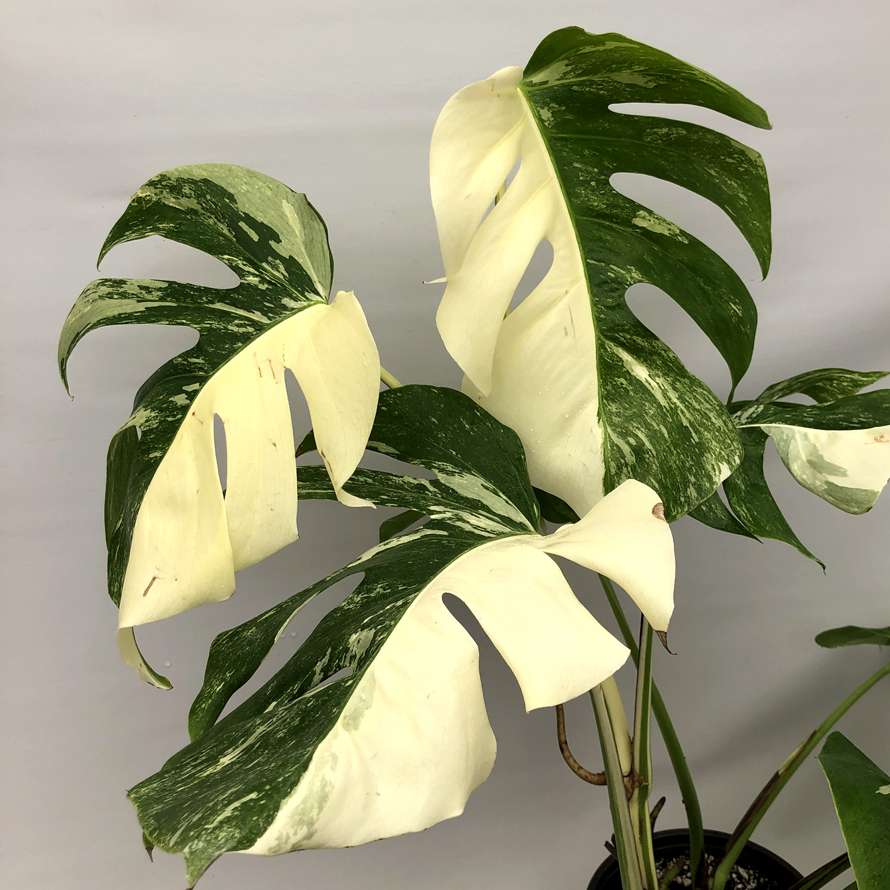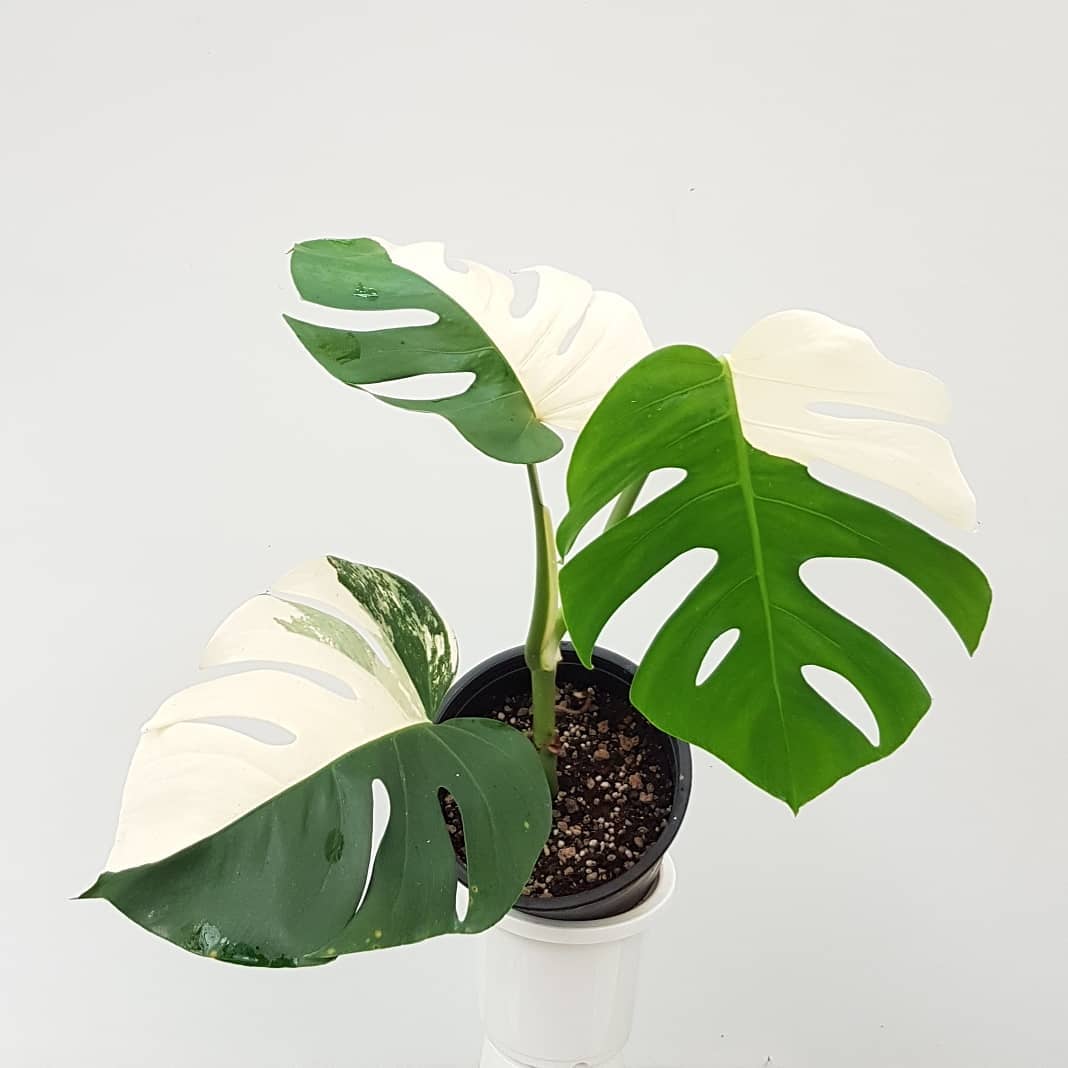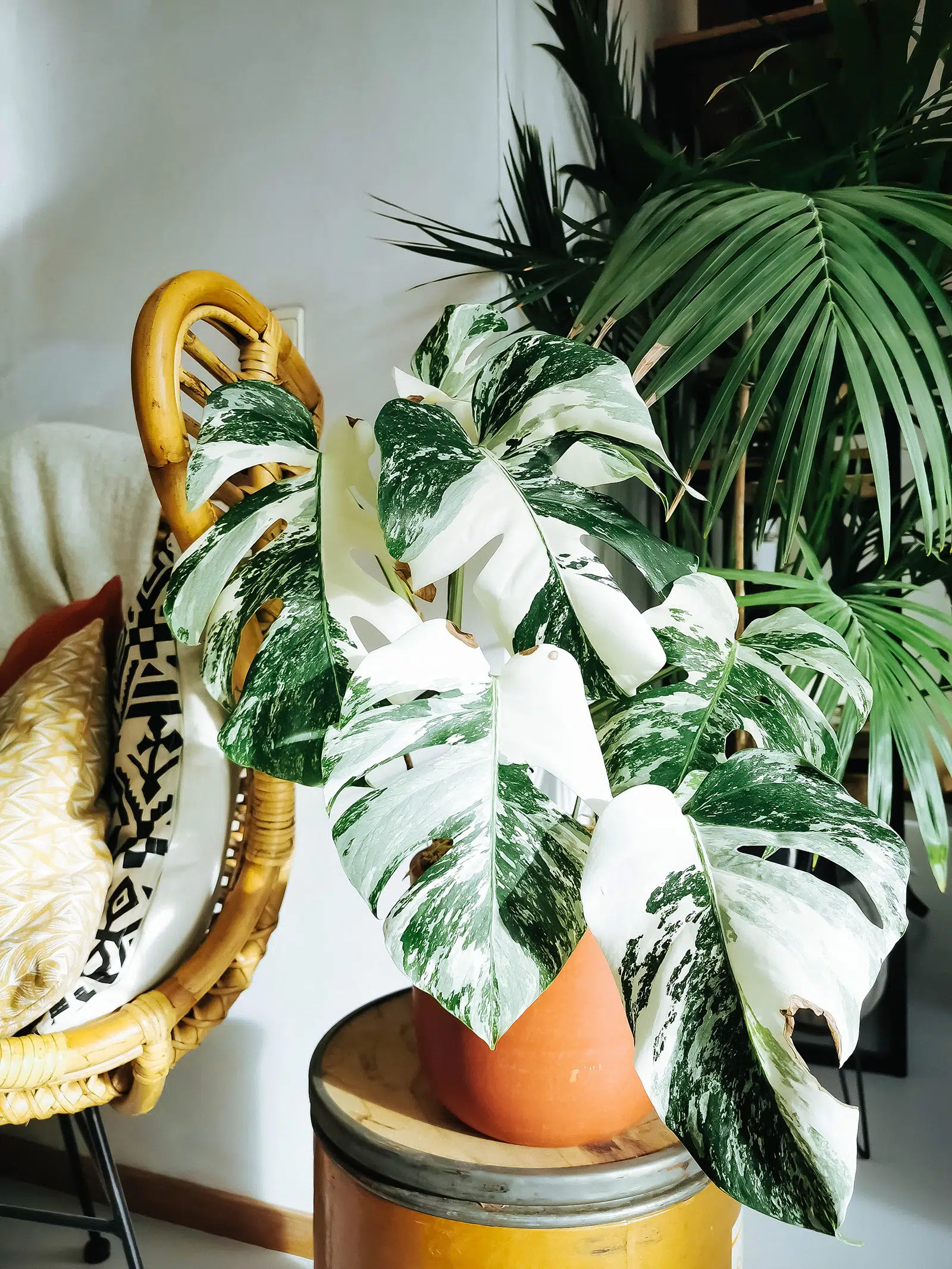Monstera Deliciosa Borsigiana Albo Variegata Care & Propagation Guide
The monstera deliciosa albo variegata, also known as the variegated monstera or Swiss cheese plant, is a stunning variant of the classic monstera deliciosa houseplant. This exotic beauty is characterized by its vibrant green leaves with striking white variegation that makes it a highly coveted and popular houseplant.

The monstera deliciosa albo variegata is a mutation of the standard monstera deliciosa, displaying white variegation on its leaves.
Natural Occurrence
This variant occurs randomly in nature through genetic mutations, where all-white leaves incapable of photosynthesis die off, while leaves with a mix of green and white survive. Leaves with this mix of color are able to photosynthesize enough to support the plant's growth.
Physical Characteristics
The monstera deliciosa albo variegata differs from the classic monstera deliciosa in the coloration of its leaves. While a standard monstera has solid green leaves, the albo variegata has stunning leaves marbled with white variegation mingled with green. The variegation occurs along the veins and inner tissue of the leaves.
This plant grows vigorously like the normal variety, climbing up trees and structures using its aerial roots. It can grow up to 20 feet tall at maturity. Its leaves start out small and develop holes and cuts as they mature, leading to its nickname “Swiss cheese plant.”
To keep your monstera deliciosa albo variegata healthy and vibrant, there are some important growing conditions to provide.
Light
Bright, indirect light is essential. Some early morning or late afternoon sun will not harm the plant as long as it is kept out of intense midday light. Insufficient light can reduce variegation over time.
Water
Water when the top inch or two of soil is dry. Too much water can lead to root rot, while too little will cause leaves to brown and Drop. Find a sweet spot to keep your plant hydrated but not saturated.
Humidity
This tropical plant thrives in average home humidity but also enjoys a boost from a humidifier or pebble tray. Mist leaves occasionally for extra moisture.
Temperature
Ideal temperatures are between 60-80°F. Keep away from cold drafts and heating vents to prevent damage.
Soil
A chunky, well-draining potting mix amended with perlite, orchid bark, or charcoal. Keep soil slightly moist but not soggy.
Propagating the monstera deliciosa albo variegata allows you to multiply your plant while retaining its coveted variegation. This is done through stem cuttings.
Obtaining Cuttings
Use a sterilized knife or shears to take a cutting below an aerial root node. Select a stem with some variegation for the highest chance it will carry through.
Preparing Cuttings
Remove lower leaves apart from one or two nodes, dip in rooting hormone, and plant in suitable soil mix. Enclose in a clear plastic bag or propagator case to retain moisture.
Caring for Cuttings
Keep warm and humid while new roots establish. Only water when soil is partly dry to prevent rotting. Gradually acclimate to normal conditions once rooted.

"Discover the Beauty of Nature! Click Here to Own a Stunning Monstera Deliciosa Albo Variegata – Elevate Your Space with this Rare and Exquisite Plant!"
While monstera deliciosa albo variegata makes an exceptional houseplant, it is susceptible to a few problems. Identifying issues early allows you to take swift action. When encountering any issues with your plant, it’s important to identify and address them promptly. For more information on solving common problems, refer to our guide on how to heal a Monstera plant.
Losing Variegation
If variegation diminishes, increase sunlight exposure. Lower light causes all-green leaves which dominate over time, reducing variegation. Prune off non-variegated stems.
Leaf Spotting & Drooping
This can indicate too much or too little water. Check soil moisture and adjust watering practices accordingly. Trim off damaged leaves.
Slow Growth
This tropical plant grows rapidly in ideal conditions. Insufficient light, low humidity, improper watering, or cool temps may cause slowed growth. Review care regimen and make adjustments to encourage new leaves.
Root Rot
Overwatering can lead to rotting roots unable to absorb moisture. Check for soggy soil, yellow leaves, slimy roots. Repot in fresh mix if needed and avoid excess water.
The monstera deliciosa albo variegata brings stunning tropical style to any indoor space. Follow these care tips to help your plant flourish. Its graceful form, alluring variegated foliage, versatility, and exotic nature make this a much-loved houseplant sure to be the highlight of your plant collection!

For ensuring the best care and maintaining the plant’s health, explore our comprehensive Monstera care instructions
With its show-stopping variegated leaves, the monstera deliciosa albo variegata is one of the most coveted houseplants among indoor gardeners. Though more challenging to source and pricier than the standard monstera deliciosa, this exotic beauty is well worth the investment for enthusiasts interested in unique varieties. Provide bright, indirect light, warmup humid conditions, proper soil mix and watering habits, and this stunner will readily climb and spread to become a focal point of awe and admiration in your home. Follow the guidance above to succeed with this prized ornamental variety.
https://bit.ly/3R7nPFC

Origin and Description
The monstera deliciosa albo variegata is a mutation of the standard monstera deliciosa, displaying white variegation on its leaves.
Natural Occurrence
This variant occurs randomly in nature through genetic mutations, where all-white leaves incapable of photosynthesis die off, while leaves with a mix of green and white survive. Leaves with this mix of color are able to photosynthesize enough to support the plant's growth.
Physical Characteristics
The monstera deliciosa albo variegata differs from the classic monstera deliciosa in the coloration of its leaves. While a standard monstera has solid green leaves, the albo variegata has stunning leaves marbled with white variegation mingled with green. The variegation occurs along the veins and inner tissue of the leaves.
This plant grows vigorously like the normal variety, climbing up trees and structures using its aerial roots. It can grow up to 20 feet tall at maturity. Its leaves start out small and develop holes and cuts as they mature, leading to its nickname “Swiss cheese plant.”
Growing Conditions
To keep your monstera deliciosa albo variegata healthy and vibrant, there are some important growing conditions to provide.
Light
Bright, indirect light is essential. Some early morning or late afternoon sun will not harm the plant as long as it is kept out of intense midday light. Insufficient light can reduce variegation over time.
Water
Water when the top inch or two of soil is dry. Too much water can lead to root rot, while too little will cause leaves to brown and Drop. Find a sweet spot to keep your plant hydrated but not saturated.
Humidity
This tropical plant thrives in average home humidity but also enjoys a boost from a humidifier or pebble tray. Mist leaves occasionally for extra moisture.
Temperature
Ideal temperatures are between 60-80°F. Keep away from cold drafts and heating vents to prevent damage.
Soil
A chunky, well-draining potting mix amended with perlite, orchid bark, or charcoal. Keep soil slightly moist but not soggy.
Propagation
Propagating the monstera deliciosa albo variegata allows you to multiply your plant while retaining its coveted variegation. This is done through stem cuttings.
Obtaining Cuttings
Use a sterilized knife or shears to take a cutting below an aerial root node. Select a stem with some variegation for the highest chance it will carry through.
Preparing Cuttings
Remove lower leaves apart from one or two nodes, dip in rooting hormone, and plant in suitable soil mix. Enclose in a clear plastic bag or propagator case to retain moisture.
Caring for Cuttings
Keep warm and humid while new roots establish. Only water when soil is partly dry to prevent rotting. Gradually acclimate to normal conditions once rooted.

"Discover the Beauty of Nature! Click Here to Own a Stunning Monstera Deliciosa Albo Variegata – Elevate Your Space with this Rare and Exquisite Plant!"
Common Issues
While monstera deliciosa albo variegata makes an exceptional houseplant, it is susceptible to a few problems. Identifying issues early allows you to take swift action. When encountering any issues with your plant, it’s important to identify and address them promptly. For more information on solving common problems, refer to our guide on how to heal a Monstera plant.
Losing Variegation
If variegation diminishes, increase sunlight exposure. Lower light causes all-green leaves which dominate over time, reducing variegation. Prune off non-variegated stems.
Leaf Spotting & Drooping
This can indicate too much or too little water. Check soil moisture and adjust watering practices accordingly. Trim off damaged leaves.
Slow Growth
This tropical plant grows rapidly in ideal conditions. Insufficient light, low humidity, improper watering, or cool temps may cause slowed growth. Review care regimen and make adjustments to encourage new leaves.
Root Rot
Overwatering can lead to rotting roots unable to absorb moisture. Check for soggy soil, yellow leaves, slimy roots. Repot in fresh mix if needed and avoid excess water.
Enjoying This Ornamental Variety
The monstera deliciosa albo variegata brings stunning tropical style to any indoor space. Follow these care tips to help your plant flourish. Its graceful form, alluring variegated foliage, versatility, and exotic nature make this a much-loved houseplant sure to be the highlight of your plant collection!

For ensuring the best care and maintaining the plant’s health, explore our comprehensive Monstera care instructions
Conclusion
With its show-stopping variegated leaves, the monstera deliciosa albo variegata is one of the most coveted houseplants among indoor gardeners. Though more challenging to source and pricier than the standard monstera deliciosa, this exotic beauty is well worth the investment for enthusiasts interested in unique varieties. Provide bright, indirect light, warmup humid conditions, proper soil mix and watering habits, and this stunner will readily climb and spread to become a focal point of awe and admiration in your home. Follow the guidance above to succeed with this prized ornamental variety.
https://bit.ly/3R7nPFC
Nhận xét
Đăng nhận xét